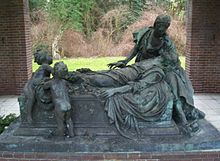Arthur Strousberg

Arthur Strousberg (born February 15 (according to other sources in October) 1850 in London , † November 22, 1873 in Cannes ; full name: Arthur James Ferdinand Strousberg ) was a German reindeer .
He was the second oldest surviving son of the general contractor, industrialist and publisher Bethel Henry Strousberg (1823-1884) and his wife Mary Ann Swan (* 1828, † 1882 in Richmond, Warrington House).
Arthur Strousberg died at the age of 23 of a lung disease during a spa stay in Cannes. Since July 20, 1871, he was married to the Englishwoman Josephine Bray, daughter of the building contractor Joseph Bray, a business partner of Bethel Henry Strousberg. Arthur and Josephine's only child, daughter Josephine Henrietta Mary, was born on May 5, 1872 in Moholz (Upper Lusatia). After his early death, Arthur Strousberg was transferred to Berlin and buried in the crypt of the Dorotheenstädtische Church . After the completion of the mausoleum of the Strousberg family in the old St. Matthäus-Kirchhof in Berlin-Schöneberg, Arthur Strousberg was transferred here.
The importance of Arthur Strousberg for posterity does not lie in his person. Rather, he deserves attention as the son of an outstanding German-English entrepreneur (and bankrupt) of the early days and in that as the object of his father's representation.
Arthur Strousberg was portrayed by Ludwig Knaus together with his parents and siblings in 1870 . The artistically and historically interesting oil painting today belongs to the Stadtmuseum Berlin Foundation and can mostly be seen in the Märkisches Museum at Köllnischer Park in Berlin.
The grave monument for Arthur Strousberg, created by Reinhold Begas in 1873/1874 on behalf of the grieving parents, is far more important. It has been in the state's own cemetery in Berlin-Reinickendorf, Humboldtstrasse 74 , since around 1913 . Here it is erected as a memorial to the fallen. The slightly larger than life work of art, cast in bronze, is one of the most outstanding sculptures of the imperial era in Germany and received a high distinction at the World Exhibition in Paris in 1900 . In 1990 the grave monument for Arthur Strousberg was presented as a central monument of neo-baroque art of historicism as part of the exhibition "Ethos and Pathos - The Berlin Sculpture School 1786–1914" in the Hamburger Bahnhof in Berlin . The “rediscoverer of the Berlin school of sculpture in the 19th century”, the Berlin-Dahlem museum director and art historian Peter Bloch (1925–1994) and the co-curator of the exhibition, Sibylle Einholz , paid special attention to the sepulcral sculpture in the catalog. In 1997 the bronze work was honored again in Karin Gummels' master's thesis “The grave monuments of Reinhold Begas” submitted to the Technical University of Berlin . As part of the exhibition "Reinhold Begas - Monuments for the Empire" shown in the German Historical Museum in Berlin in autumn 2010 , the monument again represented a research focus.
literature
- Manfred Ohlsen: The railway king Bethel Henry Strousberg. Berlin (GDR) 1987.
- Joachim Borchart: The European railway king Bethel Henry Strousberg. Munich 1991.
- Isabell von Marschall, Sven Kuhrau (Ed.): Preussens Eros, Preussens Musen. Exhibition catalog of the exhibition of the same name in the House of Brandenburg-Prussian History (HBPG) in Potsdam, 2010 (on Mary Ann Strousberg née Swan and her portrait of Gustav Graef in the Stiftung Stadtmuseum Berlin)
- Esther Sophia Sünderhauf, with the collaboration of Wolfgang Cortjaens (ed.), On behalf of the German Historical Museum, with a catalog raisonné by Jutta von Simson: Begas - Monuments for the Empire. (Exhibition catalog), contributions by Aurelia Badde, Ursel Berger, Wolfgang Cortjaens, Michael S. Cullen, Sibylle Einholz, Susanne Kähler, Jürgen Klebs, Jörg Kuhn, Gisela Moeller, Michael Puls et al. Dresden 2010.
| personal data | |
|---|---|
| SURNAME | Strousberg, Arthur |
| ALTERNATIVE NAMES | Strousberg, Arthur James Ferdinand (full name) |
| BRIEF DESCRIPTION | German reindeer and son of Bethel Henry Strousberg |
| DATE OF BIRTH | uncertain: February 15, 1850 |
| PLACE OF BIRTH | London |
| DATE OF DEATH | November 22, 1873 |
| Place of death | Cannes |
